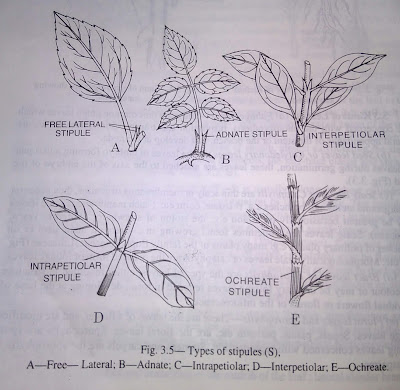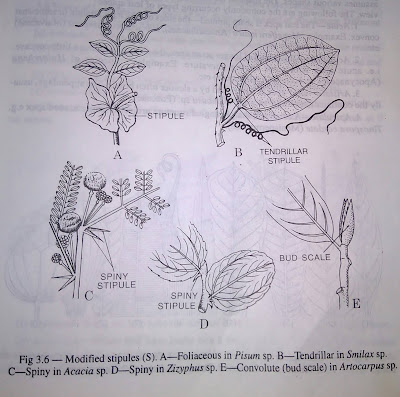The leaf
Stipules :A
stipule is the outgrowth of the hypopodium or
leaf base. Ordinarily a stipule is a tiny structure growing on both sides of a leaf at its base, but in many cases they are large and conspicuous or variously modified to discharge special functions.
 |
| Types of stipule |
KINDS OF STIPULES-There are several kinds of stipules, viz :-(i) free-lateral, (ii) adnate, (iii) intrapetiolar, (iv) interpetiolar, (v) ochreate, (vi) foliaceous, (vii) tendrillar, (viii) spinous and (ix) bud scales. .
(i) Free-lateral stipules-These are tiny slender free outgrowths on both sides of the petiole at the base. This type is found in most members of the family Malvaceae, e.g. Hibiscus rosa-sinensis (China rose), Abelmoschus esculentus.
(ii) Adnate stipules-Here the two stipules are attached with the petiole on both sides upto certain distance so that petiole-base appears to be winged, e.g. Rosa sp. (Rosaceae).
(iii) Intrapetiolar Stipules-When stipules, occurrin g on both sides of opposite leaves, unite together by their inner margins and are placed in between the leaves and stem i.e. at the axils of a leaf e. g. Gardenia jasminoides (Rubiaceae). This type is characteristic of the family Rubiaceae.
(iv) Interpetiolar stipules-These are present in most of the plants of the family Rubiaceae e.g. Ixora (Rangan), Anthocephalus indicus (Kadam) etc. These stipules are small, semi-lanceolate bodies occurring on both sides of opposite leaves, here two pairs of stipules of the two opposite leaves unite together by their outer margins-as a result the four stipules are transformed into two fused stipules and appear on two sides of the stem between the petioles of the two opposite leaves.
(v) Ochreate stipules-Ochreate stipules are sheath-like and more or less tubular in structure, enclosing greater portion of the internode. In this type several stipules unite together to 'form the enveloping sheath. These stipules are the characteristic feature of the family Polygonaceae, e.g. Polygonum barbatum (Pani marich), Rumex vesicarius (Chuka palang) etc.
 |
| Modified stipules |
MODIFIED stipules
(vi) Foliaceous stipule-Foliaceous stipules are very conspicuous and large leaflike on the both sides at the leaf base. In Pisum sativum (Papilionaceae), the foliaceous stipules look like large leaflets. In Lathyrus aphaca (Jangli matar, Papilionaceae), the entire leaf is modified into tendril, the large foliaceous semi-triangular stipules do the function of leaves.
(vii) Tendrillar stipule-In this type the stipules become modified into coily and slender tendrils which help the plants in climbing up. Tendrillar stipules are found in Smilax zeylanica (Liliaceae).
(viii) Spinous stipules are those which are modified to form spinous structures, e.g. in Capparis Spinosa (Capparidaceae), Zizyphus mauritiana (Rhamnaceae), Acacia sp‘ (Mimosaceae) etc. the stipules are modified into sharp pointed structures. These spines serve as defensive function.
(ix) Convolute stipules or Bud-scales-When stipules are modified into membranous scale-like structures and protect buds by coverin g all round, e.g., Artocarpus heterophyllus, Ficus benghalensis (Moraceae) etc. Function is protection of buds.
Fuctions of stipules : The functions of stipules are various ; these are, (a) protection of leaf bud, (b) retention of moisture in some cases, (c) function of leaves e.g. as by foliaceous stipule, (d) as defensive organs by spinous stipules, (e) as organs of support by tendrillar stipules.
Stipel-These are two small stipule-like appendages, present at the base of a leaflet in some compound leaves. Stipels are seen in many genera belonging to the family Leguminosae e.g. Dolichos lablab, Vicea faba, Desmodium sp. etc.
The Structure of various Leaf Apices : The apex of the lamina (leaf blade) assumes various shapes. The shape of the leaf apex is important from taxonomic point of view. The following are the commonly occurring types of leaf apices :
 |
| leaf apices |
1.Acute-The leaf apex is sharp pointed--the sides of which are straight or somewhat convex. Examples : Mangifera indica (Anacardiaceae), Hibiscus rosa-sinensis (Malvaceae) etc.
2. Acuminate-It is a kind of longer acute apex, the sides of which are little concave, i.e. acute apex with sides having curvature. Examples : Species of Holarrhena (Apocynaceae), Ecbolium (Acanthaceae) etc.
3. Aristate-Leaf-apex is terminated by a slender often bristle-like appendage, usually the continuation of mid-vein e.g. Bambusa sp. (Poaceae).
4. Apiculate-A small and sharply angled structure projected from rounded apex 6-8
Tinospora cordate (Menispermaceae).
5. Obtuse-When the apex is not sharply angled but blunt. Example : Ficus benghalensis (Moraceae).
6. Caudate-The leaf apex is long, slender, tail-like (caudus-tail) and terminating in a point. Example : Ficus religiosa (Moraceae).
7. Cirrhose-The leaf apex terminating into a slender coiled or tendril-like structure Examples : Musa sp. (Musaceae), FIagellaria indica (Flagellariaceae) etc.
8. Cuspidate-The apex is constricted into an eiongated sharp-pointed and rigid tip. Examples : Agave sp. (Agavaceae) and many members of the family Rubiaceae.
9. Emarginate-The leaf apex is provided with a sharp triangular notch. Examples : leaflets of some species of Cassia (Caesalpinaceae), Buxus wallichiana (Buxaceae) etc.
10. Mucronate or Cuneate-Apex is blunt or round or flat but has a short triangular point in the middle. Examples : Statice mucronata (Plumbaginaceae), Rhizophora mucronata (Rhizophoraceae), etc.
11. Retuse-The leaf apex is obtuse and with a broad shallow notch in the middle. Examples : Bauhinia sp. (Caesalpinaceae), Vaccinium sp. (Ericaceae) etc.
12. Truncate-The leaf apex is flat, more or less straight across or slightly concave as if out abruptly at the tip. Examples : Liriodendron tulipifera (Magnoliaceae).



Comments
Post a Comment